Escalator
 From Nwe
From Nwe 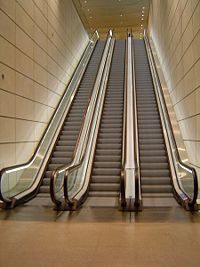
An escalator is a conveyor transport device for transporting people, consisting of a staircase whose steps move up or down on tracks that keep the surfaces of the individual steps horizontal.
A moving walkway, moving sidewalk, walkalator, travelator (colloquial name, not to be confused with Trav-O-Lator®, a registered trademark of United Technologies), or moveator is a slow conveyor belt that transports people horizontally or on an incline in a similar manner to an escalator. In both cases, riders can walk or stand. The walkways are often supplied in pairs, one for each direction.
As a power-driven, continuous moving stairway designed to transport passengers up and down short vertical distances, escalators are used around the world to move pedestrian traffic in places where elevators would be impractical. Principal areas of usage include shopping centers, airports, transit systems, trade centers, hotels, and public buildings.
The benefits of escalators are many. They have the capacity to move large numbers of people, and they can be placed in the same physical space as stairs would be. They have no waiting interval, except during very heavy traffic; they can be used to guide people towards main exits or special exhibits; and they may be weather-proofed for outdoor use.
Designs
Escalators
Escalators and their "cousins," moving walkways, are powered by constant speed alternating current motors and move at approximately 1–2 ft (0.3–0.6 m) per second. The maximum angle of inclination of an escalator to the horizontal is 30 degrees with a standard rise up to about 60 ft (18 m).
Modern escalators have metal steps in a continuous loop that move on tracks. Escalators are typically used in pairs with one going up and the other going down, however in some places, especially European stores and metro stations, there are no escalators going down; the escalators only go up. Some modern escalators in stores and shopping malls have glass sides that reveal their workings. Although most escalators are straight, some shopping malls use curved versions.
Most escalators have moving handrails that approximately keep pace with the movement of the steps. The direction of movement (up or down) can be permanently the same, or be controlled by personnel according to the time of day, or automatically be controlled by whomever arrives first, whether at the bottom or at the top (of course the system is programmed so that the direction is not reversed while somebody is on the escalator). In the last two cases, there has to be an alternative nearby.
A number of factors affect escalator design, including physical requirements, location, traffic patterns, safety considerations, and aesthetic preferences. Foremost, physical factors like the vertical and horizontal distance to be spanned must be considered. These factors will determine the pitch of the escalator and its actual length. The ability of the building infrastructure to support the heavy components is also a critical physical concern. Location is important because escalators should be situated where they can be easily seen by the general public. In department stores, customers should be able to view the merchandise easily. Furthermore, up and down escalator traffic should be physically separated and should not lead into confined spaces.
Traffic patterns must also be anticipated in escalator design. In some buildings the objective is simply to move people from one floor to another, but in others there may be a more specific requirement, such as funneling visitors towards a main exit or exhibit. The number of passengers is important because escalators are designed to carry a certain maximum number of people. For example, a single width escalator traveling at about 1.5 feet (0.45 m) per second can move an estimated 170 persons per five-minute period. Wider models traveling at up to 2 feet (0.6 m) per second can handle as many as 450 people in the same time period. The carrying capacity of an escalator must match the expected peak traffic demand. This is crucial for applications in which there are sudden increases in the number of passengers. For example, escalators used in train stations must be designed to cater for the peak traffic flow discharged from a train, without causing excessive bunching at the escalator entrance.
Of course, safety is also major concern in escalator design. Fire protection of an escalator floor-opening may be provided by adding automatic sprinklers or fireproof shutters to the opening, or by installing the escalator in an enclosed fire-protected hall. To limit the danger of overheating, adequate ventilation for the spaces that contain the motors and gears must be provided. It is preferred that a traditional staircase be located adjacent to the escalator if the escalator is the primary means of transport between floors. It may also be necessary to provide an elevator lift adjacent to an escalator for wheelchairs and disabled persons. Finally, consideration should be given to the aesthetics of the escalator. The architects and designers can choose from a wide range of styles and colors for the handrails and tinted side panels.
| Standard escalator step widths | ||||
|---|---|---|---|---|
| Size | Millimetres | Inches | Step capacity | Applications |
| Very small | 400 mm | 16 in | One passenger, with feet together | An older design, extremely rare today |
| Small | 600 mm | 24 in | One passenger | Low-volume sites, uppermost levels of department stores, when space is limited |
| Medium | 800 mm | 32 in | One passenger + one package or one piece of luggage. | Shopping malls, department stores, smaller airports |
| Large | 1000 mm | 40 in | Two passengers—one may walk past another | Mainstay of metro systems, larger airports, train stations, some retail usage |
Components
- Top and Bottom Landing Platforms—These two platforms house the curved sections of the tracks, as well as the gears and motors that drive the stairs. The top platform contains the motor assembly and the main drive gear, while the bottom holds the step return idler sprockets. These sections also anchor the ends of the escalator truss. In addition, the platforms contain a floor plate and a comb plate. The floor plate provides a place for the passengers to stand before they step onto the moving stairs. This plate is flush with the finished floor and is either hinged or removable to allow easy access to the machinery below. The comb plate is the piece between the stationary floor plate and the moving step. It is so named because its edge has a series of cleats that resemble the teeth of a comb. These teeth mesh with matching cleats on the edges of the steps. This design is necessary to minimize the gap between the stair and the landing, which helps prevent objects from getting caught in the gap.
- The Truss—The truss is a hollow metal structure that bridges the lower and upper landings. It is composed of two side sections joined together with cross braces across the bottom and just below the top. The ends of the truss are attached to the top and bottom landing platforms via steel or concrete supports. The truss carries all the straight track sections connecting the upper and lower sections.
- The Tracks—The track system is built into the truss to guide the step chain, which continuously pulls the steps from the bottom platform and back to the top in an endless loop. There are actually two tracks: One for the front wheels of the steps (called the step-wheel track) and one for the back wheels of the steps (called the trailer-wheel track). The relative positions of these tracks cause the steps to form a staircase as they move out from under the comb plate. Along the straight section of the truss the tracks are at their maximum distance apart. This configuration forces the back of one step to be at a 90-degree angle relative to the step behind it. This right angle bends the steps into a stair shape. At the top and bottom of the escalator, the two tracks converge so that the front and back wheels of the steps are almost in a straight line. This causes the stairs to lay in a flat sheet-like arrangement, one after another, so they can easily travel around the bend in the curved section of track. The tracks carry the steps down along the underside of the truss until they reach the bottom landing, where they pass through another curved section of track before exiting the bottom landing. At this point the tracks separate and the steps once again assume a stair case configuration. This cycle is repeated continually as the steps are pulled from bottom to top and back to the bottom again.
- The Steps—The steps themselves are solid, one-piece, die-cast aluminum. Rubber mats may be affixed to their surface to reduce slippage, and yellow demarcation lines may be added to clearly indicate their edges. The leading and trailing edges of each step are cleated with comb-like protrusions that mesh with the comb plates on the top and bottom platforms. The steps are linked by a continuous metal chain so they form a closed loop with each step able to bend in relation to its neighbors. The front and back edges of the steps are each connected to two wheels. The rear wheels are set further apart to fit into the back track and the front wheels have shorter axles to fit into the narrower front track. As described above, the position of the tracks controls the orientation of the steps.
- The Railing—The railing provides a convenient handhold for passengers while they are riding the escalator. It is constructed of four distinct sections. At the center of the railing is a "slider," also known as a "glider ply," which is a layer of a cotton or synthetic textile. The purpose of the slider layer is to allow the railing to move smoothly along its track. The next layer, known as the tension member, consists of either steel cable or flat steel tape. It provides the handrail with the necessary tensile strength and flexibility. On top of tension member are the inner construction components, which are made of chemically treated rubber designed to prevent the layers from separating. Finally, the outer layer, the only part that passengers actually see, is the rubber cover, which is a blend of synthetic polymers and rubber. This cover is designed to resist degradation from environmental conditions, mechanical wear and tear, and human vandalism. The railing is constructed by feeding rubber through a computer controlled extrusion machine to produce layers of the required size and type in order to match specific orders. The component layers of fabric, rubber, and steel are shaped by skilled workers before being fed into the presses, where they are fused together. When installed, the finished railing is pulled along its track by a chain that is connected to the main drive gear by a series of pulleys.
Moving walkways
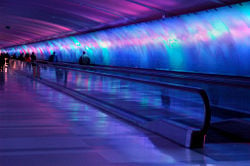
Moving walkways, also known as moving sidewalks, travelators, and walkalators, are built in one of two basic styles:
- Pallet type—a continuous series of flat metal plates mesh together to form a walkway. Most have a metal surface, though some models have a rubber surface for extra traction.
- Moving belt—these are generally built with mesh metal belts or rubber walking surfaces over metal rollers. The walking surface may have a solid feel or a "bouncy" feel.
Both types of moving walkway have a grooved surface to mesh with combplates at the ends. Also, all moving walkways are built with moving handrails similar to those on escalators.
Moving walkways are often used in airports, where there is a long distance to walk between terminals, and in metro stations.
High-speed walkways
A first attempt at an accelerated walkway in the 1980s, was the TRAX (Trottoir Roulant Accéléré), which was developed by Dassault and RATP and whose prototype was installed in the Paris Invalides metro station. It was a technical failure due to its complexity, and was never commercially exploited.
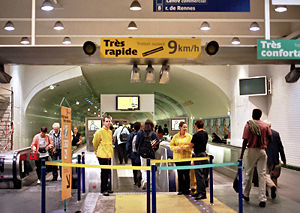
In 2002, the first successful high-speed walkway was installed in the Montparnasse—Bienvenüe Métro station in Paris. At first, it operated at 12 kilometers per hour (km/h) but too many people were falling over, so the speed was reduced to 9 km/h. It has been estimated that commuters using a walkway such as this twice a day would save 11.5 hours a year.
Using the high-speed walkway is like using any other moving walkway, except that for safety there are special procedures to follow when joining or leaving. When this walkway was introduced, staff determined who could and who could not use it. As riders must have at least one hand free to hold the handrail, those carrying bags, shopping, and so forth, or who are infirm, must use the ordinary walkway nearby.
On entering, there is a 10 m acceleration zone where the "ground" is a series of metal rollers. Riders stand still with both feet on these rollers and use one hand to hold the handrail and let it pull them so that they glide over the rollers. The idea is to accelerate the riders so that they will be traveling fast enough to step onto the moving walkway belt. Riders who try to walk on these rollers are at significant risk of falling over.
Once on the walkway, riders can stand or walk. Owing to Newton's laws of motion, there is no special sensation of traveling at speed, except for headwind.
At the exit, the same technique is used to decelerate the riders. Users step on to a series of rollers which decelerate them slowly, rather than the abrupt halt which would otherwise take place.
In 2007, a similar high-speed walkway was opened in the newly opened Pier F of Pearson International Airport in Toronto, Canada.
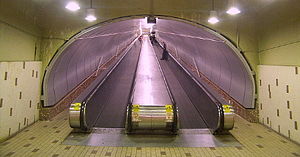
Inclined moving sidewalks
An inclined moving sidewalk, also called a movator, travelator, or moving ramp, is used in airports and supermarkets to move people to another floor with the convenience of an elevator (people can take along their suitcase trolley or shopping cart) and the capacity of an escalator. The carts have either a brake that is automatically applied when the cart handle is released, or specially designed wheels that secure the cart within the grooves of the ramp, so that it does not run away down the ramp. Some department stores instead use an escalator with a specially-designed chain, similar to those used on roller coasters, to move specially-designed carts up and down a steeper slope beside and at the same speed as the passenger escalator. The Central-Mid-levels escalator system on Hong Kong Island, Hong Kong, also has several inclined moving sidewalks. In the Melbourne suburb of Carlton, another inclined moving sidewalk can be found at Lygon Court.
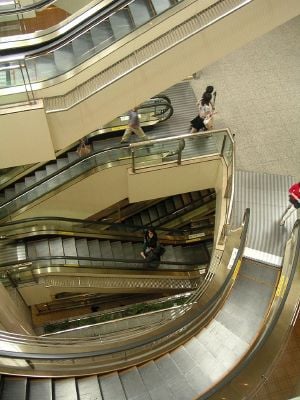
Spiral escalators
Spiral escalators take up much less horizontal space than straight escalators. However, early spiral designs were failures. For example, one spiral escalator constructed by Reno in conjunction with William Henry Aston and Scott Kietzman at London's Holloway Road Underground station in 1906, was dismantled almost immediately and little of the mechanism survives. The Mitsubishi Electric Corporation has developed successful commercial designs and has manufactured curved and spiral escalators since the 1980s.
Notable sets of spiral escalators are located in the Westfield San Francisco Centre in San Francisco, California, and at Forum Shops at Caesars Palace in Las Vegas, Nevada. The Times Square shopping mall in Causeway Bay, Hong Kong, also features four curved escalators, as does Wheelock Place in Singapore.
History
Nathan Ames, a patent solicitor from Saugus, Massachusetts, is credited with patenting the first "escalator" in 1859, despite the fact that no working model of his design was ever built. His invention, the "revolving stairs," is largely speculative and the patent specifications indicate that he had no preference for materials or potential use (he noted that steps could be upholstered or made of wood, and suggested that the units might benefit the infirm within a household use), though the mechanization was suggested to run either by manual or hydraulic power.
Jesse W. Reno, an 1883 engineering graduate of Lehigh University, invented the first escalator (he actually called it the "inclined elevator") and installed it alongside the Old Iron Pier at Coney Island, New York, in 1896. (His patent was issued in January 1892.) This particular device was little more than an inclined belt with cast-iron slats or cleats on the surface for traction, and traveled along a 25° incline. A few months later, the same prototype was used for a month long trial period on the Manhattan side of the Brooklyn Bridge. By 1898, the first of these "inclined elevators" was incorporated into the Bloomingale Bros. store at Third Avenue and 59th Street. (This was the first retail application of the devices, and no small coincidence, considering that Reno's primary financier was Lyman Bloomingdale.)[1] Reno eventually joined forces with Otis Elevator Company, and left the company after his patents were purchased outright. Some escalators of this vintage were still being used in the Boston subway until 1994-1997.
In 1892, a few months after Reno's patent was approved, George A. Wheeler patented ideas for a more recognizable moving staircase, though it was never built. Some of its features were incorporated in the prototype built by the Otis Elevator Company in 1899.
Around May 1895, Charles Seeberger began drawings on a form of escalator similar to those patented by Wheeler in 1892. This device actually consisted of flat, moving stairs, not unlike the escalators of today, except for one important detail: The step surface was smooth, with no comb effect to safely guide the rider's feet off at the ends. Instead, the passenger had to step off sideways. To facilitate this, at the top or bottom of the escalator the steps continued moving horizontally beyond the end of the handrail (like a mini-moving sidewalk) until they disappeared under a triangular "divider" which guided the passenger to either side. Seeberger teamed with Otis Elevator Company in 1899, and together they produced the first commercial escalator, which won a first prize at the Paris 1900 Exposition Universelle, in France. Also on display at the Exposition were Reno's "inclined elevator," a similar model by James M. Dodge, and two like devices by French manufacturers, including Hallé-Piat.
The first standard escalator installed on the London Underground was one such Seeberger model; it was located at Earls Court, London, UK. (London's Underground installed a rare spiral escalator designed by Jesse Reno in 1906; it was run for a short time but was taken out of service the same day it debuted.)
For a time, Otis Elevator sold both types of escalator, referring to the Seeberger model as "step-type" and the Reno model as "cleat-type." The company later combined the best aspects of both inventions (guiding slats and flat steps) and in 1921, produced an escalator similar to the type used today: They called it the "L-type" escalator.
The older lines of the London Underground had many escalators with wooden steps until they were rapidly replaced following the fire at King's Cross St. Pancras tube station in 1987. Old escalators with wooden cleated treads are still in use in some places, however, such as the Tyne Cyclist and Pedestrian Tunnel in Tyne and Wear, England, the Macy's department store in New York City, some floors of the Macy's department store in downtown Pittsburgh, Town Hall Railway Station in Sydney, and the St. Anna Pedestrian Tunnel underneath the Schelde in Antwerp, Belgium.
Standing and walking
An escalator user may choose to stand and ride at the speed of the escalator, or walk in the same direction to arrive faster. In many places—particularly on the longer escalators, used daily by commuters, found on rapid transit systems—passengers who stand customarily stay on one particular side of the escalator, leaving the other side free for walkers. The proper side for walking does not necessarily correspond with the passing lane in road traffic: Passengers stand on the right and walk on the left on the London Underground as well as the Washington, Boston, Hong Kong, Toronto, and Moscow subway systems; but in Singapore and Australia, they stand on the left. In Japan, riders stand on the left in Tokyo but on the right in Osaka. On the Montreal Metro, while walking on escalators is theoretically forbidden, this rule is scarcely observed and not at all enforced, and passengers tend to stand on the right. In some countries there is no convention and people stand on either side, randomly, as they please.
A mnemonic for the U.S./British convention on this point is that stand and right each have five letters, while walk and left have four.
Sometimes, escalators help in controlling traffic flow of people. For example, an escalator to an exit effectively discourages most people from using it as an entrance, and therefore does not require a regular ticket check. As with turnstile jumping, this can be physically defeated by someone able-bodied and determined to do so, but at the price of making themselves conspicuous. Similarly, escalators often are used as the exit of an airport secure area. Such an exit would generally be manned to prevent its use as an entrance.
For fun, people sometimes use an escalator running in the opposite direction, climbing up or down the stairs faster than it moves. This is forbidden in some places, notably the Paris Métro, where running in the opposite direction can lead to being fined.
Advertising
Escalators have recently been used by various media agencies in advertising campaigns with the handrails, side panels, or steps used for advertising. Escasite is one example of an advertising company that specializes in this.
Accidents
There have been various reports of people actually falling off a moving escalator or getting their shoe stuck in part of the escalator. A few fatal accidents are known to have involved escalators and travelators. Of these accidents, they usually involved a structural failure of the escalator.
Safety features

To reduce accidents, newer models of escalators are equipped with one or more of the following safety devices:
- Step demarcation lights—a fluorescent or LED light, traditionally colored green, is located inside the escalator mechanism under the steps at the boarding point. The resulting illumination between the steps improves the passengers' awareness of the step divisions.
- Step demarcation lines—the front and/or sides of the steps are colored a bright yellow as a warning. Earlier models had the yellow color painted on; many newer steps are designed to take yellow plastic inserts.
- Combplate impact switches—will stop the escalator if a foreign object gets caught between the steps and the combplate on either end.
- Missing step detectors—located in various places (according to brand of escalator), this sensor can either be optical or a physical switch. No matter the type of device, the missing step detector will turn off the escalator when no step is found when one is expected.
- Level step switches—switches usually located at the top and bottom of the unit near the track hold-downs. These switches will detect an unlevel step before it approaches the combplate. This is to stop the escalator before the unlevel step crashes into the combplate, possibly preventing injury to a passenger.
- Handrail speed sensors—located somewhere inside of the escalator unit. These sensors are usually optical, they are positioned to sense how fast the handrail is going. In case of a drive chain/belt breaking, in order to protect the drive and people on the escalator, if the sensor notices a speed difference between the handrail and the steps, it will sound an alarm, wait for a couple of seconds, then stop the escalator. A hard fault is generated inside the controller, and therefore must be serviced by authorized personnel.
- Handrail inlet switches—located at the bottom and top of the unit. These sensors guard the opening where the handrail enters and exits the escalator. If something gets caught between the handrail and the opening, a hard fault is generated in the controller and the escalator shuts down.
- Skirt brush—a long continuous brush made of stiff bristles runs up the sides of the escalator just above the step level. This helps keep loose garments and curious hands away from the dangerous gap between the moving stairs and the side panel.
- Raised edges—the sides of the steps are raised slightly to discourage standing too close to the edge.
- Flat steps—the first two or three steps at either end of the escalator are flat, like a moving walkway. This gives the passenger extra time to orient him/herself when boarding, and more level time to maintain balance when exiting. Longer escalators, especially those used to enter a subterranean metro station, often have four or more flat steps.
- Antislide devices—these are raised circular objects that often stud the escalator balustrade. They are sometimes informally called "hockey pucks" due to their appearance. Their purpose is to prevent objects (and people) from precipitously sliding down the otherwise smooth metallic surface.
- Emergency Stop button—At each end of the escalator (in the London Underground also on the balustrade), a large red button can be pressed to stop the escalator. A transparent plastic guard plate (usually alarmed) often covers the button, to avoid the button being pressed accidentally, or for fun by children and casual vandals. Restarting requires turning a key.
- Safety instructions—posted on the balustrades at either end. Formerly, the only warning usually given was "PLEASE HOLD YOURSELF" or some variation thereof (and, in models that used now-rare smooth step risers, had such a message right on the step face). Now, a series of instructions are given (see below).
Safety tips
While some escalator accidents are caused by a mechanical failure, most can be avoided by following some simple safety precautions.
- Hold the handrail.
- Do not use the escalator when transporting any large package or when pushing a device with wheels (moving sidewalks and ramps usually excepted—look for signs). This includes: baby strollers, baggage carts, hand trucks, or shopping carts. Also, the escalator should not be used by someone with a walker or on crutches.
- Check for loose garments. These may include: Long dresses, scarves, trench coats, or loose belts. Also, loose shoelaces are particularly notorious for getting caught in escalator machinery, so make sure that shoes are tied.
- Keep footwear away from the side panels—especially shoes with traction.
- Children under the age of 7 should be accompanied by an adult when riding.
- Do not ride barefoot.
- Face forward.
- Carry dogs up or down (or use the elevator).
- Keep walking after exiting the escalator to prevent a pile-up.
- Stand to one side of the escalator to allow others to pass.
- No ice-skates should be worn when using an escalator.
Longest escalators and systems
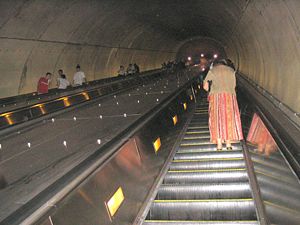
Longest systems
In Hong Kong, tens of thousands of commuters travel each work day between Central, the central business district, and the Mid-levels, a residential district hundreds of feet uphill, using a long distance system of escalators and moving sidewalks called the Central-Mid-Levels escalator. It is the world's longest outdoor escalator system (not a single escalator span), at a total length of 800 meters (m). It goes only one way at a time; the direction reverses depending on rush hour traffic direction. The Ocean Park, in Hong Kong, also has a long escalator system connecting two parts of the Park, with an overall length of 224 m (745 feet). In the Times Square shopping center in Causeway Bay there is a bank of four spiral escalators, each of which turns through about 180 degrees—by necessity, the undersides of these escalators are thicker as the step return mechanism needs to be more complex than on a straight escalator.
Longest individual escalators
The longest individual escalators in the world are found on the metro systems in several cities in Eastern Europe; those in St. Petersburg, Kiev, and Prague have Soviet-era escalators up to approximately 100 m (330ft) long. The longest of all these are in the famously deep Moscow Metro, in the Park Pobedy station. Opened in 2003, these escalators are 126 m long and take nearly three minutes to transit.
The longest single span uninterrupted escalator in the Americas is at the Wheaton station of the Washington Metro system. It is 70 m (230 ft) long, and takes almost 2 minutes and 45 seconds to ascend or descend without walking.
The longest escalator on the London Underground system, and indeed in Western Europe, is at Angel station with a length of 60 m, and a vertical rise of 27.5 m. The longest escalator on the Helsinki Metro is at Kamppi metro station with a length of 65 m, and a vertical rise of 29.7 m, including 334 steps.
The longest freestanding escalator in the world is inside a huge atrium at CNN Center in Atlanta, Georgia. It rises 8 stories and is 205 ft (62 m) long. Originally built as the entrance to the Krofft-themed indoor amusement park, The World of Sid and Marty Krofft, the escalator is now used for CNN studio tours.
Science fiction
The concept of a megalopolis based on high-speed walkways is common in science fiction. The first work set in such a location is When The Sleeper Wakes (1899) written by H. G. Wells (also republished as The Sleeper Awakes), and takes place in London around the year 2100. In the 1927 silent film, Metropolis, there are several scenes showing moving sidewalks and escalators between skyscrapers at high levels. Later, The Roads Must Roll (1940), written by Robert A. Heinlein, depicts the risk of a transportation strike in a society based on similar-speed sidewalks. The novel is part of the Future History saga, and takes place in 1976. Isaac Asimov, in the novel, The Caves of Steel (1954), and its sequels in the Robot Series, uses similar enormous underground cities with a similar sidewalk system. The period described is about the year 3000.
In each of these cases there is a massive network of parallel moving belts, the inner ones faster. Passengers are screened from wind, and there are chairs and even shops on the belt. In the Heinlein work the fast lane runs at 180 km/h, and the first "mechanical road" was built in 1960 between Cincinnati and Cleveland. The relative speed of two adjacent belts is an unrealistic 20 km/h (in the book the fast lane stops, and the second lane keeps running at 160 km/h). In the Wells and Asimov works, there are more steps in the speed scale and the speeds are less extreme.
In Arthur C. Clarke's novel, Against the Fall of Night (later rewritten as The City and the Stars) the Megacity of Diaspar is interwoven with "moving ways" which, unlike Heinlein's conveyor belts, are solid floors that can mysteriously move as a fluid. On pages 11-13 of the novel, Clarke writes,
An engineer of the ancient world would have gone slowly mad trying to understand how a solid roadway could be fixed at both ends while its center traveled at a hundred miles an hour… The corridor still inclined upwards, and in a few hundred feet had curved through a complete right-angle. But only logic knew this: To the senses it was now as if one were being hurried along an absolutely level corridor. The fact that he was in reality traveling up a vertical shaft thousands of feet deep gave Alvin no sense of insecurity, for a failure of the polarizing field was unthinkable.
Lore
It is reputed that the first escalator was designed and partially built by Reese Williams, great grandfather of Jim Williams, co-owner of Gennesee Valley Water Bottling Company, and an immigrant from Wales. He owned a small carpentry shop where he originally got the idea for the escalator. Unfortunately, he did not think to patent his idea before finishing his prototype, and openly talked to his local community about his project. One day, he went to open the shop, and found that it had been burned to the ground, with none of his plans intact. Within the next week the patent for the escalator was filed with the U.S. patent office. It is unknown as to whether or not the plans were stolen or this was simply a coincidence.
Etymology
Escalator was originally a combination of the word "scala," which is Latin for steps, and the word "elevator," which had already been invented. The verb form of the word is (to) escalate and is commonly applied to the use of increased force in warfare.
The word Escalator started out as a trademark of the Otis Elevator Company. Otis, however, failed to police its usage sufficiently, so escalator became a generic term in 1950. But until then, other manufacturers had to market their escalators under different names. The Peelle Company called theirs a Motorstair, and Westinghouse called their model an Electric Stairway. The Haughton Elevator company (now part of Schindler Group) referred to their product as simply, Moving Stairs.
Notes
- ↑ Diane H. De Fazio, Lifting Me Higher: Escalators, their History and Preservation (Master's Thesis, Columbia University Graduate School of Architecture, Planning, and Preservation, 2007).
References
ISBN links support NWE through referral fees
- Cooper, David A., and John Inglis. Elevator and Escalator Micropedia. Essex, UK: International Association of Elevator Engineers, 2006. ISBN 095256968X.
- Goetz, Alisa. Up, Down, Across: Elevators, Escalators, and Moving Sidewalks. London, UK: Merrell, 2003. ISBN 1858942136.
- Strakosch, George R. The Vertical Transportation Handbook. Hoboken, NJ: Wiley, 2001 (original 1998). ISBN 0471162914.
External links
All links retrieved August 16, 2017.
- Walkway propels Paris metro into future, a BBC article on the high-speed travelator at Gare Montparnasse station in Paris.
- Videoclip (on 'youtube') showing the Parisian high speed walkway. This clip is hand held, and at times it is a little unsteady. Towards the end of the clip note how the other people leaving the moving walkway stand with both feet firmly on the ground and one hand on the handrail whilst passing through the deceleration zone.
- The Elevator Escalator Safety Foundation
- Escalator troubles rooted in Metro's original design.
- A 'self starting escalator.' Escalators running needlessly when no-one is around consume energy and incur extra 'wear & tear', both of which add to the operating costs. To find a balance between what is needed and what is just 'convenient' escalators at quieter locations are sometimes configured to only start moving when people are about to travel on them. Self starting escalators are very difficult to demonstrate by means of static photographs, but this feature is clearly seen in action in this 13 second hand-held video clip named 'Essen-self-starting-escalator320.mpg'.
Credits
New World Encyclopedia writers and editors rewrote and completed the Wikipedia article in accordance with New World Encyclopedia standards. This article abides by terms of the Creative Commons CC-by-sa 3.0 License (CC-by-sa), which may be used and disseminated with proper attribution. Credit is due under the terms of this license that can reference both the New World Encyclopedia contributors and the selfless volunteer contributors of the Wikimedia Foundation. To cite this article click here for a list of acceptable citing formats.The history of earlier contributions by wikipedians is accessible to researchers here:
- Escalator history
The history of this article since it was imported to New World Encyclopedia:
- History of "Escalator"
Note: Some restrictions may apply to use of individual images which are separately licensed.
↧ Download as ZWI file | Last modified: 02/04/2023 04:51:47 | 39 views
☰ Source: https://www.newworldencyclopedia.org/entry/Escalator | License: CC BY-SA 3.0
 ZWI signed:
ZWI signed: KSF
KSF